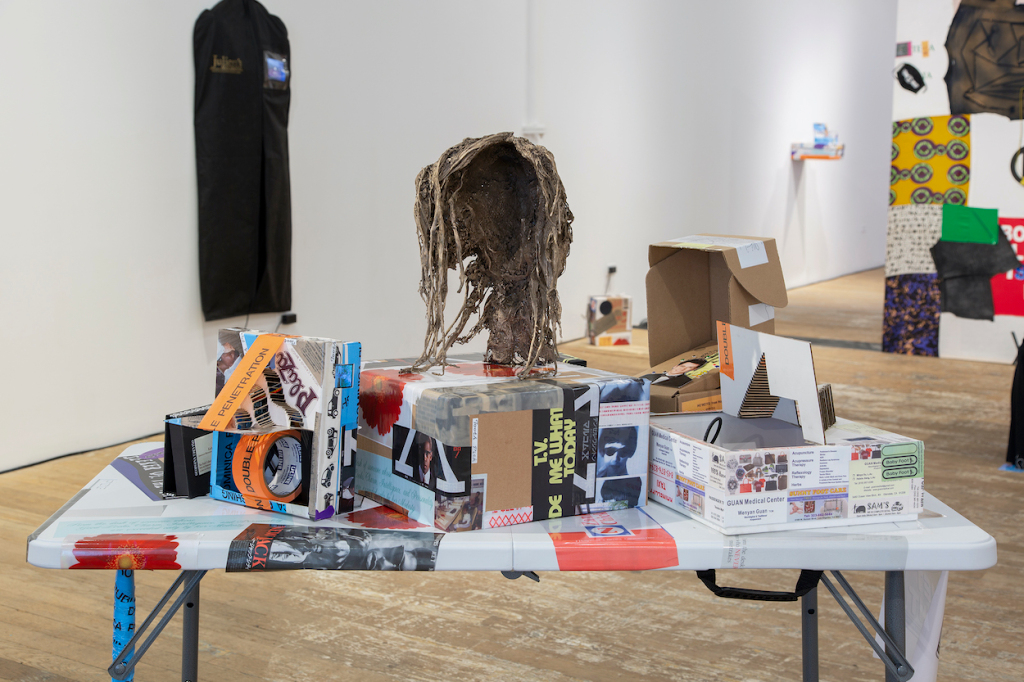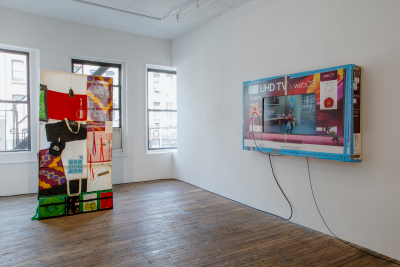 Martine Syms, Merch table, 2021, collapsible table, plastic, metal, indigo prints with adhesive backing, tape, 29 by 48 by 24 inches. Photo Gregory Carideo/Courtesy the artist and Bridget Donahue, NYC DOUBLE PENETRATION reads the orange shipping tape that wraps, secures, or embellishes the majority of the sculptures on view (all works 2021) in Martine Syms’s show at Bridget Donahue. Abbreviated DP, the term shares an acronym with Dominica Publishing, the name of Syms’s imprint, emblazoned on the other, blue shipping tape similarly wrapped around table legs, adhered to sculptures, and cut up in collages. These colorful insertions look like stickers for a streetwear brand, wryly “packaging” Syms’s practice, which encompasses visual art, fashion, design, and publishing. By juxtaposing these two DPs—one a sex act and the other a side practice that puts out books and merchandise on Blackness and visual culture (including goods related to this show)—the artist seems to signal her ambivalence toward the commercialization of her work and self. How to make art within a culture where Blackness is a desirable brand to wear, but a fraught identity to bear?
Martine Syms, Merch table, 2021, collapsible table, plastic, metal, indigo prints with adhesive backing, tape, 29 by 48 by 24 inches. Photo Gregory Carideo/Courtesy the artist and Bridget Donahue, NYC DOUBLE PENETRATION reads the orange shipping tape that wraps, secures, or embellishes the majority of the sculptures on view (all works 2021) in Martine Syms’s show at Bridget Donahue. Abbreviated DP, the term shares an acronym with Dominica Publishing, the name of Syms’s imprint, emblazoned on the other, blue shipping tape similarly wrapped around table legs, adhered to sculptures, and cut up in collages. These colorful insertions look like stickers for a streetwear brand, wryly “packaging” Syms’s practice, which encompasses visual art, fashion, design, and publishing. By juxtaposing these two DPs—one a sex act and the other a side practice that puts out books and merchandise on Blackness and visual culture (including goods related to this show)—the artist seems to signal her ambivalence toward the commercialization of her work and self. How to make art within a culture where Blackness is a desirable brand to wear, but a fraught identity to bear?
Part of Syms’s response is an exaggeration of this commercialization, largely through adoption of the “bootleg” aesthetics of some vendors in the surrounding Chinatown. Merch Table is one of the first things one sees in the exhibition, titled “Loot Sweets.” It displays a set of slapdash arts and crafts projects in the way some might arrange sunglasses, hats, and counterfeit designer bags for sale on the streets outside. On Syms’s table, business cards for acupuncture, car detailing, and taxi services cover shoe box sculptures. There’s also a bronze cast of a hair weave, one roll of each DP shipping tape, and various small screens that resemble old flip phones. Nearby is 99¢ Bowery Gang Gang, a sculpture involving black T-shirts stretched over a spindly chair, the title a riff on the gallery’s address, 99 Bowery. The artist wants the show to look like a bargain store, and fills it with rip-off versions of her own brand, even if the works will likely sell for much more than their counterparts outside. This fraught deployment of “poverty aesthetics,” whether citing Chinatown or low-income communities more generally, ironically troubles Syms’s critique of commercialization.
 View of “Martine Syms: Loot Sweets,” 2021, at Bridget Donahue, showing Soliloquy, 2021, and She read this thing recently, about “the dissonance of the black spotlight, of being revered in one way and reviled in another, a revulsion that makes clear the hollowness of the reverence.”, 2021. Photo Gregory Carideo/Courtesy the artist and Bridget Donahue, NYC
View of “Martine Syms: Loot Sweets,” 2021, at Bridget Donahue, showing Soliloquy, 2021, and She read this thing recently, about “the dissonance of the black spotlight, of being revered in one way and reviled in another, a revulsion that makes clear the hollowness of the reverence.”, 2021. Photo Gregory Carideo/Courtesy the artist and Bridget Donahue, NYC
It also seems that Syms arrived at this gesture—making purposely cheap-looking things—as a sort of “fuck you” to the expectations placed on her as a Black artist of note, as if to say: You want me to be a high-quality brand? I will rip you off. Syms is so desirable, the show suggests, that she can offer patched-up or thrown-together things, and people will still want them. That attitude carries over into the display of three videos, shown on flat-screen TVs in shabby packaging rather than through projections in the sexy, minimalist screening rooms more common today. Soliloquy, for example, uses the DP packing tapes to comic effect: the edges of the box are sealed with blue Dominica Publishing tape, but orange Double Penetration tape forms an asterisk where a wire “penetrates” the cardboard, the hole patched over with another sticker whose slogan captures the show’s wry approach to value: “Highest Quality Black Art.”
Soliloquy also serves as a key to the exhibition in its formal play with skin and screen. Syms suggests that what we wear forms our social skin, online and off. She literalizes this process in three freestanding “screens” that structurally resemble paintings or mobile projection walls, over which are stretched collaged fabrics made of tote bags and T-shirts bearing the names and symbols of “cool” brands. The largest, titled Dominica Publishing Paris, incorporates fabric with a large Telfar logo, two tiny Jacquemus bags, and a B&H Photo hat. Another work near the window (the light from which passes through the fabrics, as in a physical screen) involves a Video Data Bank tote bag, Dominica Publishing lanyards, and an Eckhaus Latta label. These brands have been staples of the hip young crowd that has frequented Lower Manhattan’s “Dimes Square” area since the late 2010s. One title in this series, What Artists Wear, more pointedly identifies the conflation of brands and identities. It’s hard to discern Syms’s stance on these symbols of taste; the crookedly quilted pieces suggest some kind of critique of this culture, but they seem more like diaristic records of participation.
Indeed, Syms’s comments on commercialism land between an embrace and a lament. In and beyond this show, she has chosen to engage with the image industry—collaborating with Helmut Lang, Nike, and Prada—rather than sit outside it. Here, she studies other Black icons: in a pastel drawing of Lil Nas X titled Lilith’s Brood / My Hero Lil Nas X (Montero); a display of Janet Jackson’s clothes, acquired via auction, in the work Loot Sweets, the show’s namesake; and her videos that feature an imagined character, Kita, who appears as the loquacious host of an MTV-style show (Soliloquy) or a wellness guru (Kita Meditating). Most important, she studies herself as a Black icon, as in DED, the largest video in the show, in which a digital avatar resembling Syms stumbles around a blank white space, occasionally stabbing and shooting and reviving herself. “To Hell With My Suffering,” reads the T-shirt on the avatar’s back as she bleeds out. Here, representation is a paycheck, a funhouse, and a crime scene.
Source link : https://www.artnews.com/art-in-america/aia-reviews/martine-syms-bridget-donahue-dominica-1234603737












